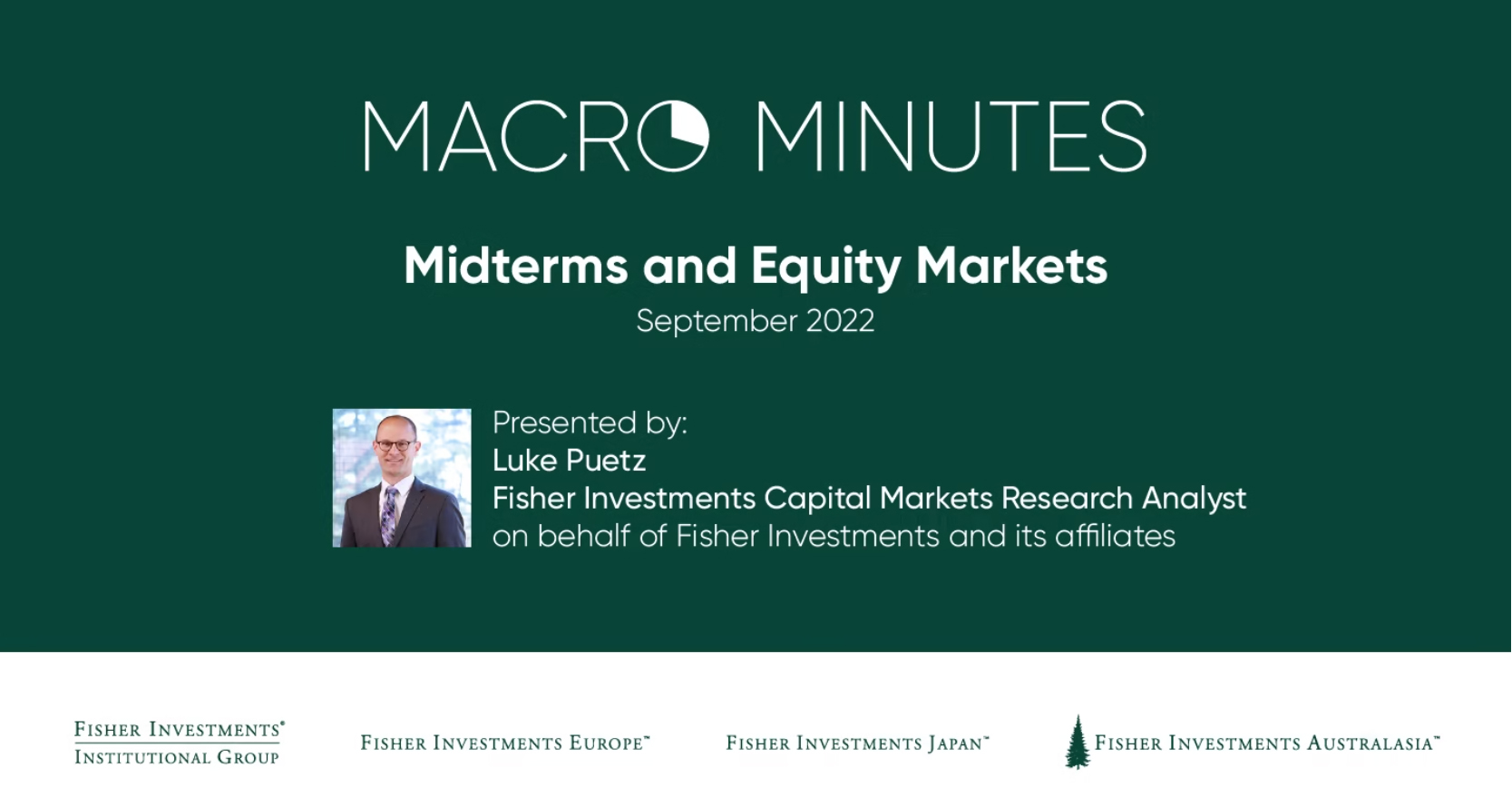Institutional Investing / Macro Insights
Macro Minutes: Midterms and Equity Markets

In our most recent Macro Minutes video, Capital Markets Research Analyst Luke Puetz explains how Fisher Investments views the upcoming US midterm election given today’s inflationary environment and discusses how it could impact equity markets.
Key Points
- Equity markets are about to enter the phase in the US presidential election cycle with the strongest historical returns, the three consecutive quarters that begin with the midterm election.
- The president’s party tends to lose seats in midterm elections, often resulting in a gridlocked government that produces fewer legislative changes, which creates a more stable and orderly environment for business.
- Historically, gridlock promotes a “goldilocks” environment of slow-steady growth with low inflation. For this reason, given today’s uniquely high inflation and fears of tight monetary policy, the upcoming midterm could be a uniquely powerful tailwind for equities.
Transcript
|
Visual |
Audio |
|---|---|
|
Title screen appears, “Macro Minutes, Midterms and Equity Markets September 2022. Presented by Luke Puetz, Fisher Investments Capital Markets Research Analyst on behalf of Fisher Investments and its affiliates.” |
|
|
A man appears on the screen in a dark navy suit wearing glasses sitting in a conference room. He begins to speak. |
Luke Puetz: Hello my name is Luke Peutz and I'm a capital markets analyst with Fisher Investments. And today I'm going to be talking about the relationship between the US midterm election and equity markets. |
|
A chart appears on the screen, “Midterm election years tend to be back-ended loaded. For equities, the strongest phase of the four-year presidential election cycle is the three quarters beginning with the midterm election.” |
Luke Puetz: When we make market forecasts, we look at a variety of political, economic and sentiment drivers. But in today's presentation, I want to focus on one particular political driver that we believe could be a big tailwind for stocks moving forward. The US midterm election. Now, when discussing politics, we want to emphasize that we are politically agnostic. We favor neither party over the other. Our interest in discussing politics is to understand how political events can affect markets. Luke Puetz: This chart is showing average returns of the S&P 500 going back to 1925, but particularly focusing on the second and the third year of the US presidential election cycle. And what you see is similar to this year. Returns tend to be relatively subdued in the early part of the midterm election year. However, as you move towards the end of the midterm election year and going into the first half of the following year, stocks historically do very well. In fact, that three fourths period is historically the strongest phase throughout the whole four year presidential election cycle. Luke Puetz: Now, any time you see some sort of a relationship in the stock market, you might want to ask yourself whether or not there's actually causation between that relationship. But what we want to show you in this presentation is that we do believe there is a relationship between those strong equity market returns and the midterm election when a new US president enters office |
|
A new chart appears on the screen, “The President’s party tends to lose seats in midterms. The US government is likely to become increasingly gridlocked, which means the pace of legislative change is likely to slow.” |
Luke Puetz: It’s frequently the case that there's a unified government, which means that one party is in control of the presidency, the House of Representatives and the Senate. And in that sort of an environment, it's relatively easy for the government to pass legislation, which means there's more legislative activity which can create more disorder. Markets tend to not do as well in that sort of an environment where lots of legislative change is creating winners and losers. Luke Puetz: However, as you get towards the midterm election, it's frequently the case that the president's party actually loses seats. This table shows you that in the House of Representatives, the president's party loses seats 89% of the time, and in the Senate, the president's party loses seats 71% of the time. So given the very narrow historical margins that the Democrats hold in both the House and Senate, we believe it's likely that we're probably going to have gridlock after the midterm election this year. Luke Puetz: The chart at the bottom is actually showing betting market odds, which show that the Republicans have a 75% chance, according to the betting markets, of winning at least one chamber of Congress. What that means is we go into next year, we're probably going to be in an environment of gridlock where there's going to be much less legislative change. That's going to create a more stable and predictable environment, which stocks tend to favor. |
|
A new chart appears on the screen, “Commodity prices and FED rate hikes during unified vs. gridlock governments. Less inflation and less hawkish Fed policy generally followed prior midterm elections that created political gridlock.” |
Luke Puetz: This year, two of the biggest market concerns have been inflation and the Federal Reserve's response to high inflation, which is tight monetary policy. This chart helps to illustrate why we believe the midterm election could actually help alleviate some of those fears. So I want you to focus first on the green and the white bars in the background of this chart. The white bars show periods of unified government and the green bars show periods of gridlocked government. The red circles are showing the particular US midterm elections that resulted in a transition from unified government to gridlock. Luke Puetz: The top chart is showing commodity prices. In particular, we're showing oil prices and copper prices. And then in the bottom chart, we're showing the federal funds rate, which is the short term interest rate that the Federal Reserve uses to control inflation. So if you take a step back and look at this chart, what you see is in the periods of unified government where you tend to get much more change. Commodity prices tend to rise. And in response to that higher inflation, the Federal Reserve tends to tighten monetary policy. Luke Puetz: But then as we move past the midterm election, we enter these periods of gridlock. You see in those periods of less change, more stability. You'll see that commodity prices slowly tend to dissipate and weaken. And in response to that weaker inflation, the Federal Reserve will back away from that tighter monetary policy. So if you think about what could potentially happen next year in 2023 with a gridlocked environment, it's very plausible in our view, that we could see a lot of these inflation fears going away and a lot of these fears about tight monetary policy going away, which could create an environment where stocks do very well as uncertainty declines. |
|
A new chart appears on the screen, “Bear Market thoughts are common before midterm elections. Seven of the past ten S&P 500 bear markets (from 1962-2020) reached a cycle low in the six months preceding a US midterm election.” |
Luke Puetz: Now, here in 2022, we've already had a bear market. So one question you might have moving forward is might this bear market continue? Might we see more lows? And that's certainly possible. We don't really make short term predictions. But if the bear market does continue, we think it's not likely to last much further. Luke Puetz: This chart here is showing you the S&P 500 going back to 1960 and the red dots are highlighting US midterm elections. And what you can see is that bear markets tend to hit a bottom near midterm elections very frequently. In fact, of the past ten S&P 500 bear markets, seven of them have reached a final trough in the six months preceding US midterm elections. Luke Puetz: Further, if you focus on the period of the 1960s and the 1970s, which is a period that had historically higher inflation and higher interest rates, similar to what we're seeing this year, you'll see that a lot of those bear market troughs are concentrated in that period which very well could be related to the high inflation and the effect of the midterm on inflation. |
|
Luke Puetz appears back on the screen. |
Luke Puetz: So hopefully, this presentation has helped give you a little bit of context about why we believe the US midterm election could be a particularly important driver for stocks moving forward. Thank you for watching. If you have any questions, please reach out to your relationship manager. |
|
Luke Puetz: A closure screen appears, “Thank you for watching! If you would like to learn more about our views, please reach out to your relationship manager or email fisherinstitutional@fi.com A series of disclosures appears on the screen “Investing in Securities involves a risk of loss. Past performance is never a guarantee of future returns. Investing in foreign stock markets involves additional risks, such as the risk of currency fluctuations. The foregoing constitutes the general views of Fisher Investments and should not be regarded as personalized investment advice or a reflection of the performance of Fisher Investments or its clients. Nothing herein is intended to be a recommendation or a forecast of market conditions. Rather it is intended to illustrate a point. Current and future markets may differ significantly from those illustrated here. Not all past forecasts were, nor future forecasts may be, as accurate as those predicted herein.” |
|
See Our Institutional Insights
Stay on top of the latest investment trends and developments with our views and research.




